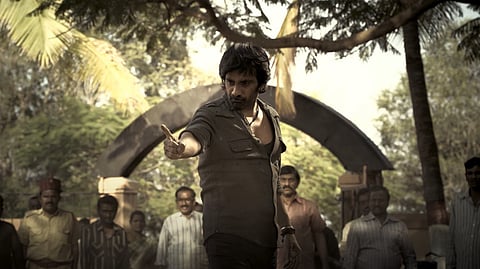Tiger Nageswara Rao review: Ravi Teja’s film portrays a sensitive subject without nuance
Tiger Nageswara Rao (Telugu)(1.5 / 5)
Ravi Teja’s Tiger Nageswara Rao was one of the most anticipated films of the year. Apart from Ravi Teja, who plays the title character, the film stars Nupur Sanon, Gayatri Bhardwaj, Renu Desai, Anupam Kher, Murali Sharma, and others. Directed by Vamsee, the story is inspired by the life of the ‘notorious’ thief named in the title who hailed from Stuartpuram, a village in Andhra Pradesh’s Guntur. Nageswara Rao apparently got the moniker ‘Tiger’ after he escaped from a high security prison in Chennai.
Stuartpuram was a ‘reformatory settlement’, virtually an open air prison for communities that were notified as ‘criminals’ under the Criminal Tribes Act 1871 enacted by the British. The marginalised Yerukula community, categorised as Scheduled Tribe, faced severe oppression after being declared ‘criminals’. The landlords exploited their vulnerability and used them as cheap labour. As part of the ‘reformation’, the police had to teach the community discipline and punctuality, which effectively meant harassment.
I was curious to see how director Vamsee would treat this subject given that it has many layers.
The story of Tiger Nageswara Rao begins in the 1990s. The Prime Minister’s office convenes a high-level meeting to gather information about a dacoit from Andhra Pradesh. And Vamsee falters right at the beginning when he delivers a heady cocktail of KGF and Pushpa. The premise, the dialogues, the narrative, the elevation draws heavy inspiration from KGF. In fact, inspiration would be an understatement. It is an exhaustingly cheap version of KGF that is lacking in originality.
The opening train robbery action sequence is atrocious with subpar CGI work. Even Ravi Teja’s face seems to have been corrected in post-production, which was extremely distracting.
The first half of the film is quite shocking when it tries to show the Yerukula people, who have been shunned by society owing to their social location, as animals. They are depicted as people who ‘hunt’ humans, eat pigs, and drink the blood of donkeys to gain strength. Besides, it shows Tiger Nageswara Rao as an uncouth and vulgar man who is a pervert, reinforcing the caste prejudices. It would be dishonest of the director to some extent if he denies that he did not pander to Ravi Teja’s fans by making him spew crass dialogues that objectify women and show him sexually harassing them.
The first half and the second half of the film appear as two distinct parts, which becomes a huge drawback for Tiger Nageswara Rao. After the initial KGF hangover, Vamsee shows the oppressed group more humanely. In essence, the actual story begins only after 1.5 hours. In retrospect, I understand the idea behind this, but it did not work for the film.
The film also has dubbing issues. Actors Anupam Kher, Nupur Sanon, and Gayatri Bhardwaj can clearly be seen mouthing dialogues in Hindi. Ravi Teja tries to change his voice modulation and attempt a different look. But he does not fit the part.
Some of the film’s action scenes are ludicrous, to say the least. Ravi Teja decapitates goons by swinging a sword as if they are flowers. While Madhie’s cinematography and the art direction is impressive, nothing else – including GV Prakash’s music – is able to salvage the film.
Tiger Nageswara Rao is an anti-caste film. The dialogue: “Stealing is not in our blood but we were forced by circumstances” or the reference of Dr BR Ambedkar breaking the shackles of an oppressed group shows what Vamsee wants to convey. He also does not shy away from exposing how the police treated the people of the community. And how they suffered for years under the landlords, police, and the Salvation Army, a missionary organisation entrusted with ‘reforming’ them. Interestingly the director does not address the question of caste explicitly. It is for the audience to decipher the clues scattered in the story.
However, presenting a sensitive subject in a commercial format without nuance results in Tiger Nageswara Rao ending up as a lousy film.
The story of Stuartpuram is one of pain, suffering, and discrimination. A nomadic group was forced to live in a settlement under surveillance. The system did not discriminate between women and children and treated everyone as criminals. Till date, the residents of Stuartpuram face the stigma of being considered thieves or of hailing from a village of dacoits. I only wish that Tiger Nageswara Rao had been executed better and changed this perception.
Disclaimer: This review was not paid for or commissioned by anyone associated with the film. Neither TNM nor any of its reviewers have any sort of business relationship with the film’s producers or any other members of its cast and crew.

